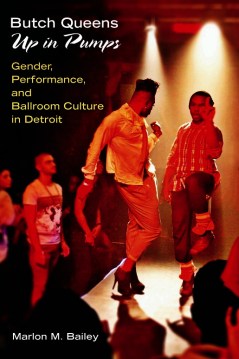Real-life LGBTQ communities formed under bizarre, secretive and often dangerous conditions and evolved under a tight knot of social and political factors. Writing the history of a community that formerly did its best to stay hidden is a tough job, but through recording oral histories and conducting years of research, many authors have done just that, birthing irreplaceable reference materials into our tender hands.
I’ve not read all of these myself, but I know there are heaps of gender studies majors and otherwise nerdy LGBTQ history people in this community, so if you’ve read any of these, comment and let everybody know what you think! We know a lot of stuff you guys. Let’s tell each other everything we know.
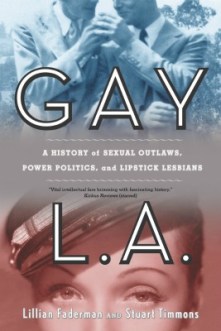 1. Gay L. A.: A History of Sexual Outlaws, Power Politics, and Lipstick Lesbians, by Stuart Timmons and Lillian Faderman
1. Gay L. A.: A History of Sexual Outlaws, Power Politics, and Lipstick Lesbians, by Stuart Timmons and Lillian Faderman
I liked this one so much that I bought my own copy after reading the whole thing out of the library. I reference it all the time. Back in the day, it was really difficult for women to be financially independent from men and it was pretty much impossible to become legitimately wealthy without a man — unless, of course, you were an actress in Hollywood, where it wasn’t unusual for a single woman to have her own estate. Obviously the book was about a lot more than that, but I am VERY interested in Power Lesbian History, so. Lillian Faderman is also the author of Odd Girls and Twilight Lovers: A History of Lesbian Life in Twentieth-Century America, which, while imperfect in many ways, is what got me interested in lesbian history in the first place.
2. Queer Twin Cities, by the Twin Cities GLBT Oral History Project (2010)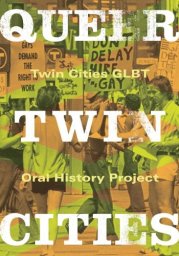
So much queer history is focused on either coast, but The Twin Cities GLBT Oral History project — “a collective organization of students, scholars and activists devoted to documenting and interpreting the lives of GLBT people in Minneapolis and St.Paul” wants to change that. “The notion that San Francisco and L.A. have functioned as cities of gay salvation while the Midwest is a place of gay suicidal despair should sit uneasy with a Minnesota audience,” writes Jennifer L. Pierce in the introduction to this essay collection. “The Twin cities, after all, have a history of gay radical activism as long and deep as that found in coastal cities.”
3. Boots of Leather, Slippers of Gold: The History of a Lesbian Community, by Elizabeth Lapovsky Kennedy and Madeline D. Davis (1993)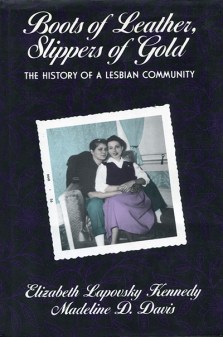
Described as “the first comprehensive history of a working-class lesbian community,” this book centered on Buffalo, in upstate New York, took its authors fourteen years of research to put together. They draw on the oral histories of 45 women to present “poignant and complex stories show how black and white working-class lesbians, although living under oppressive circumstances, nevertheless became powerful agents of historical change.” Far too often the only histories that survive are those of the white upper classes, but this book goes far and wide to provide a different story, with a special attention paid to butch/femme dynamics in history. You can read more about this book in “Six Ways that 1950s Butches and Femmes F*cked with Society, Were Badass.”
4. Butch Queens Up in Pumps: Gender, Performance, and Ballroom Culture in Detroit, by
So this isn’t about lesbian history, and I haven’t actually read it, BUT I wanted to include it because it sounds so cool and because it’s about Detroit, which has a special place in my heart forever. Stories about ball culture are often limited to New York, but the scene was so much more expansive than that. Here you go: “Butch Queens Up in Pumps examines Ballroom culture, in which inner-city LGBT individuals dress, dance, and vogue to compete for prizes and trophies. Participants are affiliated with a house, an alternative family structure typically named after haute couture designers and providing support to this diverse community. Marlon M. Bailey’s rich first-person performance ethnography of the Ballroom scene in Detroit examines Ballroom as a queer cultural formation that upsets dominant notions of gender, sexuality, kinship, and community.”
5. There Goes the Gayborhood?, by Amin Ghaziani (2014)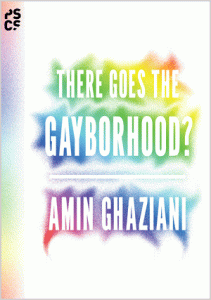
I drew on this book a lot in order to write Where Do Lesbians Live? — as the title suggests, this book traces the evolution of gay neighoborhoods in the US throughout history and asks why so many gayborhoods have priced so many members of the LGBTQ community out. The author, Amin Ghaziani, is a gay man of color who lives in Chicago and he conducted extensive interviews with members of the LGBTQ community in Chicago to accurately depict the radical and unfortunate transformation taking place in these legendarily “safe spaces.”
6. Wide-Open Town: A History of Queer San Francisco to 1965, Nan Alamilla Boyd (2005)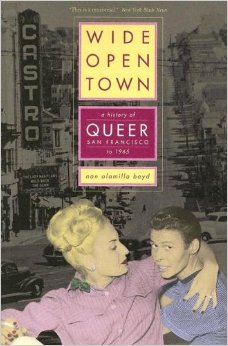
The pathway by which San Francisco became a haven for sexual “deviants” is a long and fascinating one, which Nan Alamilla Boyd dives clam-first into in this extensive history of the area. From the book description: “Wide-Open Town traces the history of gay men and lesbians in San Francisco from the turn of the century, when queer bars emerged in San Francisco’s tourist districts, to 1965, when a raid on a drag ball changed the course of queer history. Bringing to life the striking personalities and vibrant milieu that fueled this era, Nan Alamilla Boyd examines the culture that developed around the bar scene and homophile activism. She argues that the communities forged inside bars and taverns functioned politically and, ultimately, offered practical and ideological responses to the policing of San Francisco’s queer and transgender communities. Using police and court records, oral histories, tourist literature, and manuscript collections from local and state archives, Nan Alamilla Boyd explains the phenomenal growth of San Francisco as a “wide-open town”—a town where anything goes.”
7. Safe Space: Gay Neighborhood History and the Politics of Violence,  by Christina Hanhardt (2013)
by Christina Hanhardt (2013)
This takes a different angle that isn’t about the specific historical evolution of a certain town, but how the local LGBTQ activist energy around street violence in various towns with significant gay populations inadvertently led to some “broader public safety initiatives that have sought solutions in policing and privatization and have had devastating effects along race and class lines.” It won the Lambda Literary Award for LGBT Studies in 2014.
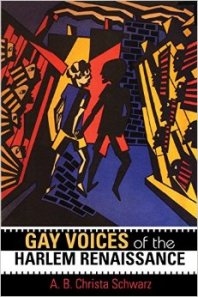 8. Gay Voices of the Harlem Renaissance (Blacks in the Diaspora), by A.B. Christa Schwarz (2003)
8. Gay Voices of the Harlem Renaissance (Blacks in the Diaspora), by A.B. Christa Schwarz (2003)
Schwarz aims to fill the void in scholarship where the accomplishments of women, bisexuals and homosexuals have been sidelined when chronicling this enormously influential era in American cultural history, centered, as it was, around one specific neighborhood in New York. The Gay & Lesbian Review writes that Schwarz “comes up with fascinating nuggets of information not found in other sources.” Although the focus is on men, specifically Counte Cullen, Langston Hughes, Claude McKay and Richard Bruce Nugent, there’s still lots of fantastic nuggets to be had.
Here are 19 more books I wish I had time to read, with descriptions from the book themselves:
9. Cherry Grove, Fire Island: Sixty Years in America’s First Gay and Lesbian Town, by Esther Newton (1993) – “Based on interviews with 46 former and current residents, the author chronicles the colony’s development from an isolated few cabins to a thriving, commercial, publicized community with Mafia-run discos and occasional police raids.”
10. Lonely Hunters: An Oral History Of Lesbian And Gay Southern Life, 1948-1968, by James Sears (1997) – “In Lonely Hunters, James Sears, noted gay writer, academic, and media commentator, has compiled the real stories of gay men and lesbians who were raised in the social hierarchy of the South and who recall their coming of age when the status quo of American society as a whole was on the cusp of great upheaval.”
11. City of Sisterly and Brotherly Loves: Lesbian and Gay Philadelphia, 1945-1972, by Mark Stein (2000) – “In this pathbreaking history, Marc Stein takes an in-depth look at Philadelphia from the 1940s to the 1970s. What he finds is a city of vibrant gay and lesbian households, neighborhoods, commercial establishments, public cultures, and political groups.”
12. Queering India: Same-Sex Love and Eroticism in Indian Culture and Society, edited by Ruth Vanita (2001) “The essays focus on pre-colonial, colonial, and post-colonial gay and lesbian life in India to provide a comprehensive look at a much neglected topic. The topics are wide-ranging, considering film, literature, popular culture, historical and religious texts, law and other aspects of life in India.”
13. In A Queer Country: Gay & Lesbian Studies in the Canadian Context, edited by Terry Goldie (2002) “In a Queer Country confronts queer culture from various perspectives relevant to international audiences. Topics range from the politics of the family and spousal rights to queer black identity, from pride parade fashions to lesbian park rangers.”
14. Provincetown: From Pilgrim Landing to Gay Resort (American History and Culture), by Karen Krahulik (2007) – “How did a sleepy New England fishing village become a gay mecca? In this dynamic history, Karen Christel Krahulik explains why Provincetown, Massachusetts—alternately known as “Land’s End,” “Cape-tip,” “Cape-end,” and, to some, “Queersville, U.S.A”—has meant many things to many people.”
15. A Lesbian History of Britain: Love and Sex Between Women Since 1500, by Rebecca Jennings (2007) – “Covering landmark moments and well-known personalities (such as Radclyffe Hall and the publication and banning of her lesbian novel The Well of Loneliness), but also examining the lives and experiences of ordinary women, it brings both variety and nuance to their shared history. In doing so, it also explores cultural representations of, and changing attitudes to, female same-sex desire in Britain.”
16. Out and Proud in Chicago: An Overview of the City’s Gay Community, edited by Tracy Baim (2008) – “Out and Proud in Chicago takes readers through the long and rich history of the city’s LGBT community. Lavishly illustrated with color and black-and white-photographs, the book draws on a wealth of scholarly, historical, and journalistic sources. Individual sections cover the early days of the 1800s to World War II, the challenging community-building years from World War II to the 1960s, the era of gay liberation and AIDS from the 1970s to the 1990s, and on to the city’s vital, post-liberation present.”
17. Queer Ricans: Cultures and Sexualities in the Diaspora (Cultural Studies of the Americas), by Lawrence La Fountain-Stokes (2009) – “Exploring cultural expressions of Puerto Rican queer migration from the Caribbean to New York, Philadelphia, Chicago, and San Francisco, Lawrence La Fountain-Stokes analyzes how artists have portrayed their lives and the discrimination they have faced in both Puerto Rico and the United States.”
18. Changing Times: Almanac and Digest of Kansas City’s Gay and Lesbian History, by David W Jackson (2011) – “The ‘gay liberation’ movement launched in Kansas City in February 1966, when the National Planning Conference of Homophile Organizations (NPCHO) was established to form a national coalition of gay and lesbian leaders. This first-ever, truly national coalition of ‘LGBT’ (lesbian, gay, bisexual and transgender) leaders decided to meet at the State Hotel (northeast corner of 12th & Wyandotte; since demolished) in downtown Kansas City, Missouri. In 2011, we recognize the 45th anniversary of this historic local event with national impact with the introduction of this almanac and digest to begin chronicling Kansas City’s LGBT past.”
19. Bulldaggers, Pansies, and Chocolate Babies: Performance, Race, and Sexuality in the Harlem Renaissance, by James F. Wilson (2011) – “Bulldaggers, Pansies, and Chocolate Babies shines the spotlight on historically neglected plays and performances that challenged early twentieth-century notions of the stratification of race, gender, class, and sexual orientation.
20. Re-Dressing America’s Frontier Past, by Peter Boag (2011) – “Delving into countless primary sources and surveying sexological and literary sources, Boag paints a vivid picture of a West where cross-dressing—for both men and women—was pervasive, and where easterners as well as Mexicans and even Indians could redefine their gender and sexual identities.”
21. Queer Activism in India: A Story in the Anthropology of Ethics, by Naisargi Dave (2012) – “In Queer Activism in India, Naisargi N. Dave examines the formation of lesbian communities in India from the 1980s to the early 2000s. Based on ethnographic research conducted with activist organizations in Delhi, a body of letters written by lesbian women, and research with lesbian communities and queer activist groups across the country, Dave studies the everyday practices that constitute queer activism in India.”
22. Chicago Whispers: A History of LGBT Chicago before Stonewall, by St. Sukie de la Croix (2012) – “Chicago Whispers illuminates a colorful and vibrant record of lesbian, gay, bisexual, and transgendered people who lived and loved in Chicago from the city’s beginnings in the 1670s as a fur-trading post to the end of the 1960s. Journalist St. Sukie de la Croix, drawing on years of archival research and personal interviews, reclaims Chicago’s LGBT past that had been forgotten, suppressed, or overlooked.”
23. Land of 10,000 Loves: A History of Queer Minnesota, by Stewart Van Cleve (2012) – “Land of 10,000 Loves blends oral history, archival narrative, newspaper accounts, and fascinating illustrations to paint a remarkable picture of Minnesota’s queer history.”
24. The End of San Francisco, by Mattilda Bernstein Sycamore (2013) – “Using an unrestrained associative style to move kaleidoscopically between past, present, and future, Sycamore conjures the untidy push and pull of memory, exposing the tensions between idealism and critical engagement, trauma and self-actualization, inspiration and loss. Part memoir, part social history, and part elegy, The End of San Franciscoexplores and explodes the dream of a radical queer community and the mythical city that was supposed to nurture it.”
25. Tomboys and bachelor girls: A lesbian history of post-war Britain 1945-71, by Rebecca Jennings (2013) – “Using a rich array of oral histories and archival sources, Tomboys and bachelor girls provides the first detailed academic study of lesbian identity and culture in post-war Britain.”
26. The Gentrification of the Mind: Witness to a Lost Imagination, by Sarah Schulman (2013) – “Schulman takes us back to her Lower East Side and brings it to life, filling these pages with vivid memories of her avant-garde queer friends and dramatically recreating the early years of the AIDS crisis as experienced by a political insider. Interweaving personal reminiscence with cogent analysis, Schulman details her experience as a witness to the loss of a generation’s imagination and the consequences of that loss.”
27. Gay Berlin: Birthplace of a Modern Identity, by Robert Beachy (2014) – “From Karl Heinrich Ulrichs, a German activist described by some as the first openly gay man, to the world of Berlin’s vast homosexual subcultures, to a major sex scandal that enraptured the daily newspapers and shook the court of Emperor William II—and on through some of the very first sex reassignment surgeries—Robert Beachy uncovers the long-forgotten events and characters that continue to shape and influence the way we think of sexuality today.”
28. Steel Closets: Voices of Gay, Lesbian, and Transgender Steelworkers, by Anne Balay (2014)- In Steel Closets, Anne Balay draws on oral history interviews with forty gay, lesbian, and transgender steelworkers, mostly living in northwestern Indiana, to give voice to this previously silent and invisible population. She presents powerful stories of the intersections of work, class, gender, and sexual identity in the dangerous industrial setting of the steel mill.”
So have you read any of these books? Let us know!




